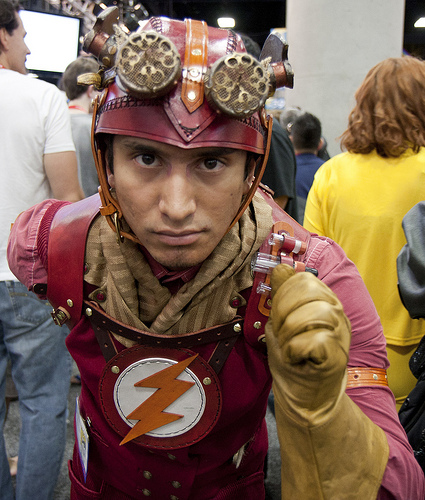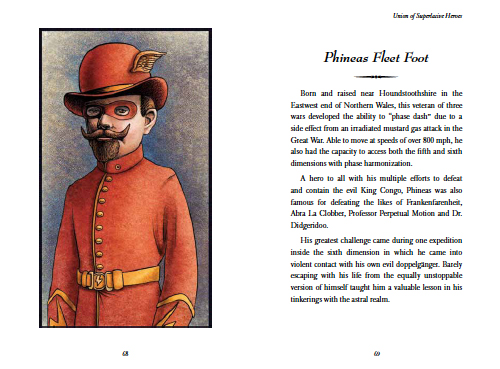This Steampunk Flash costume was designed and built by Dustin Fletcher of Penny Dreadful and Cathy Jones of God Save The Queen Fashions.
Fletcher and Jones each write about their parts of the costume after the jump.

Photo by Nathan Rupert.

This Steampunk Flash costume was designed and built by Dustin Fletcher of Penny Dreadful and Cathy Jones of God Save The Queen Fashions.
Fletcher and Jones each write about their parts of the costume after the jump.

Photo by Nathan Rupert.
As fandom moves onto the next big convention of the season, I hope you’ll take a few moments to look back at San Diego and the people who dressed as the Flash (and related speedsters) at Comic-Con International.
United Underworld’s incredible gender-swapped Justice League, featuring Psykitten Pow’s Flash. Photo by John Austin.
It turns out that the Flash was the inspiration for the group theme:
“A couple of us like to do female versions of preexisting male characters. One of our friends, Psykitten Pow, she had a female Flash,” says Tallest Silver, who organized the group and who dresses as Batma’am. “One night, we were all hanging out and I said how funny it would be if we had a whole Justice League with swapped sexes.”
Photograph by Chuck Cook Photography.
The group previously appeared at WonderCon, and Psykitten appeared as the Flash last year. Continue reading
For those of you who have been waiting for pictures of the San Diego Comic Con exclusive Professor Zoom, you need not wait any longer. Our very own friendly neighborhood webmaster and Flash historian, Kelson Vibber attended SDCC 2011 and managed to snag an exclusive DC Direct/Graphitti Designs Flashpoint Professor Zoom action figure. Let’s take a closer look:
I’ve completed my full convention write-up for this year’s Comic-Con International. Here’s hoping I’ll be spending a few more days in San Diego next summer!
One of the booths I stumbled across at Comic-Con was selling trading cards and books featuring the Union of Superlative Heroes and Order of Nefarious Villains: steampunk characters inspired by certain well-known super-heroes and villains.
I had to pick up a set just for this one:

Phineas Fleetfoot, able to run at more than 800mph, phase into the fifth and sixth dimensions, and protect the world from the likes of King Congo, Frankenfahrenheit, Professor Perpetual Motion, Abra Le Clobber, and Dr. Didgeridoo.
The heroes set includes Marquis Le Bat and Duchesse Le Bat, Flatiron Knight, Arachno Kid, the Magic Lantern, Baron von Ocular, and more.
I was sorely tempted by the hand-bound flip book featuring both heroes and villains with additional stories, but couldn’t quite bring myself to spend $45 on it. Then I got home, really looked through the cards I’d bought, and regretted missing my chance.
Huzzah for the internet. When the artists got back from the con, they made the remaining stock available through Etsy.
Image c/o Chet Phillips Illustration.
DC editorial insisted repeatedly over the weekend that there’s no escape hatch, no trap door, no possible way for the old DC Universe to return after the New 52 establishes itself post-Flashpoint.
This is, to put it mildly, an exaggeration.
If the last decade at DC comics has shown us anything, it’s that a determined writer with a supportive editor (or a determined editor with a willing writer) can undo any change he wants, no matter how set in stone it was before.
There was no back door put in place during Crisis on Infinite Earths to bring back Kara Zor-El as Supergirl, or Krypto, or any of the Silver-Age elements of the Superman mythos that were removed by the “Man of Steel” reboot, but they came back anyway. Emerald Twilight was deliberately written to make it impossible to bring back Hal Jordan as Green Lantern, but we not only got Hal back, we got the Guardians and the entire Corps. Neither the reboot nor threeboot Legion of Super-Heroes set up a way to go back to the previous version, and yet the pre-Zero Hour Legion is back in action.
Marv Wolfman actually did write a trap door into Barry Allen’s death in Crisis on Infinite Earths. The idea was that, since he was running through time at the time he died, he could be plucked out of that run at any point for more adventures, but would live always knowing that he would eventually have to go back and sacrifice himself. It sat there, unused, for over 20 years, and when DC eventually brought Barry back to life, they did it another way, without using the trap door.
Trap doors don’t matter.
What matters is editorial direction.
When Dan Didio, or Eddie Berganza, or Jim Lee stands up there on stage at Comic-Con and says, “There’s no escape hatch,” they don’t mean they’ve set up the premise so that no one can go back. If they really want to, they’ll find a way.
It’s just an “in-story” way of saying that they’re committed to the new direction and determined to see it through.